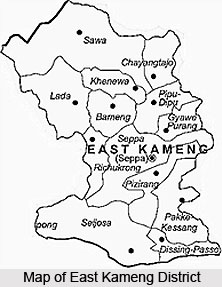 History of East Kameng district narrates the course of events that led to the formation of the district. East Kameng district was formed by the house-listing operation of the census of 1981. According to Re-organisation of District Act, 1980, Kameng district was categorized into two districts namely West Kameng and East Kameng. Seppa is the district headquarters of East Kameng district and was the sub divisional head quarters of the former of Kameng district. The district is further divided into two subdivisions namely Chayengtajo and Seppa.
History of East Kameng district narrates the course of events that led to the formation of the district. East Kameng district was formed by the house-listing operation of the census of 1981. According to Re-organisation of District Act, 1980, Kameng district was categorized into two districts namely West Kameng and East Kameng. Seppa is the district headquarters of East Kameng district and was the sub divisional head quarters of the former of Kameng district. The district is further divided into two subdivisions namely Chayengtajo and Seppa.
The name Kameng has been derived from a tributary of the Brahmaputra River, known as Kameng River. The district was initially a part of Darrang district, Assam, till the year 1914. By a Government of India Notification of 1914, the area of this district was made a part of the "western section" of the `North East Frontier Tract`. In the year 1919 the region under the Balipara Frontier Tract was categorized into Subansiri Area and Sela-Agency. Sela Sub-Agency was renamed in 1954 as the Kameng Frontier Division. The headquarters was shifted to Bomdila. This division was again renamed as Kameng district in 1965. The district underwent bifurcation in May 1980 into East Kameng district and West Kameng district.
In 1971, the area under this district was under the North East Frontier Agency, which in turn was constitutionally a part of Assam. The administration of this agency was controlled by the President of India through the Governor of Assam. In the year 1972, the agency was converted into a Union Territory and was named as Arunachal Pradesh. The administration of Arunachal Pradesh was then assigned to a Chief Commissioner and Shillong was made the head quarters. Legislative Assembly was formed in this Union Territory on 15th of August 1975 which comprised of the Chief Minister, Lt. Governor appointed as the Chief Administrator and a cabinet of four ministers to assist him. The headquarters was then shifted to Itanagar in Lower Subansiri district.
Panchayat Raj was introduced under the Panchayat Raj Regulation, 1967, in the East Kameng district. As per the regulation, at the village level Gram Sabhas were formed, at the block level Anchal Samities existed, at district level Zilla Parishad operated and at the Agency level the Agency Council existed. However, after the formation of the Legislative Assembly the Agency Council lost its identity.
The administrative responsibility of Seppa subdivision of East Kameng district is assigned to the Deputy Commissioner General who is under the authority of an Additional Deputy Commissioner. The entire administration of the district is controlled by the Deputy Commissioner. The lowest unit of the administrative machinery of the East Kameng district is known as a `circle` which is taken care of by a Circle Officer. Presently the district has 13 circles. By definition, a circle is a group of villages. Traditional village councils are the customary administrative system of the villages. The village councils have the authority to settle all civil and some criminal cases that falls within their jurisdiction and this authority has been granted by the Assam Frontier Regulation, 1945. The Deputy Commissioner has also been granted the powers of session`s judges whereas some officers have been given magisterial powers. The Arunachal Police also assists the authorities of the district in the maintenance of law and order. Since its formation the district has been dominated by the scheduled tribes of the state of Arunachal Pradesh.



















